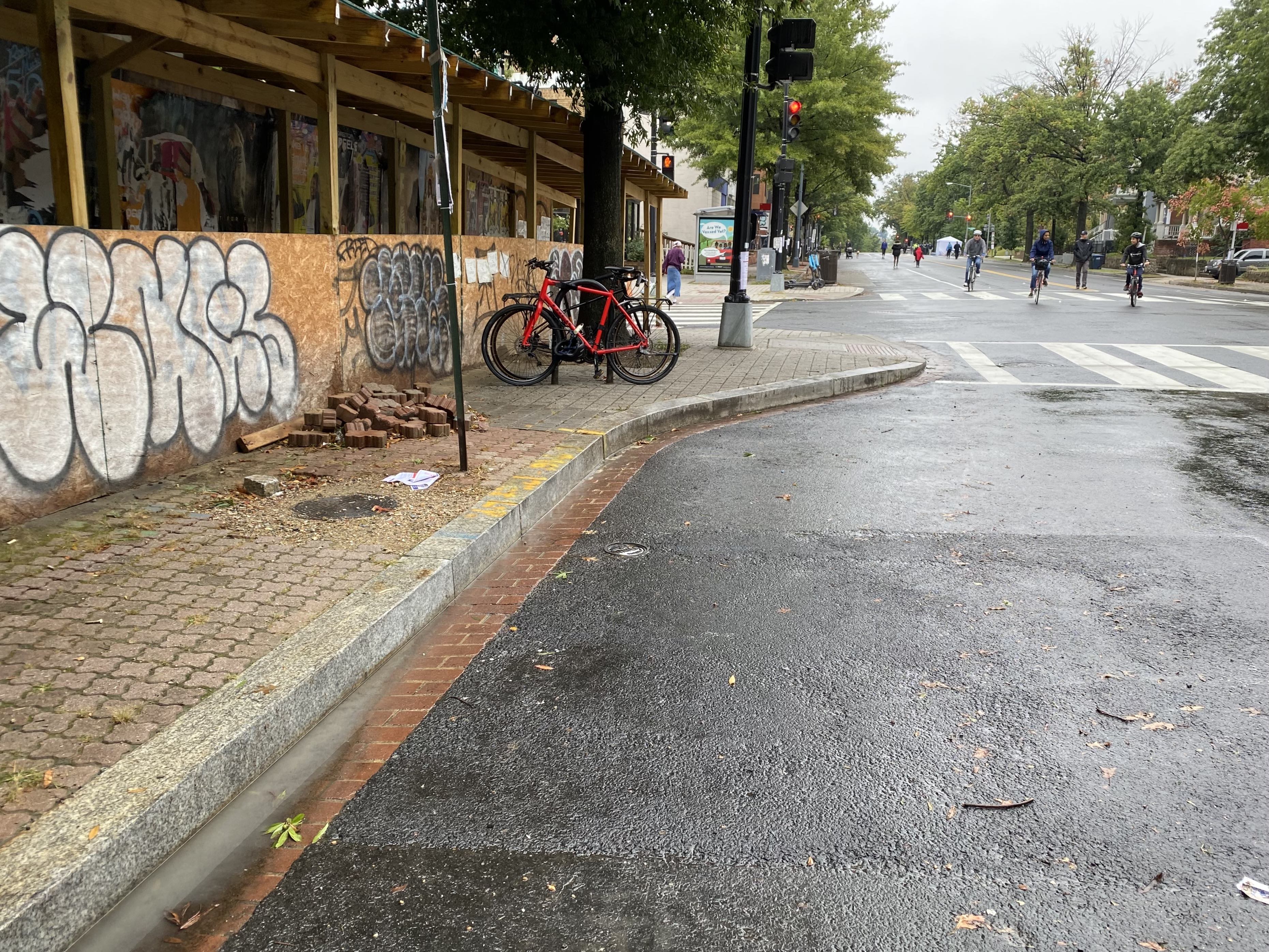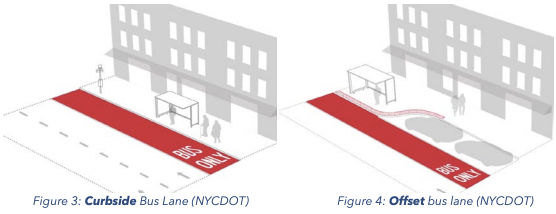This community concern runs along the boundary of 5C07, as well as through many other SMDs in 5B, 5C, and 5F
tl;dr
- Rhode Island Ave NE generally has off-peak street parking along the curbside lane, and this has been the case for decades.
- Off-peak parking (also referenced as peak/rush-hour parking restrictions) is the condition of street parking being allowed most of the time, but not during peak roadway volume (generally 7:30am-9am inbound or 4-6:30pm outbound, Monday through Friday).
- This condition creates a number of problems, prevents any adaptive reuse of the curbside lane in small portions, and has major implications for future bus lanes.
- Some of Rhode Island Ave NE has been reprogrammed to 24/7 parking, in other words ending rush-hour parking restrictions
- I’m working to request a study by DDOT to expand 24/7 parking along Rhode Island Ave. You can read the draft here and add your signature here.
The Problem with Off-Peak Parking
Off-peak parking is the condition of allowing street parking only outside of weekday rush-hour. These may also be called peak (or rush-hour) parking restrictions. In DC, this generally means:
- parking on the outbound side is disallowed from 4pm to 6:30pm Monday through Friday
- parking on the inbound side of the roadway is disallowed from 7:30am to 9am Monday through Friday
This condition theoretically allows for through traffic to make use of an extra lane during peak usage times. Traffic modeling software would appear to weigh this factor when considering the congestion of a roadway given expected traffic volumes.
However, I believe there are a number of problems with this.
Induced Volume
It is accepted that introducing roadway capacity induces roadway use, a phenomenon known as induced demand. In this way, the extra lane is as much creating new roadway volume as it is accommodating it.
Limited Utility
Consistency is an important factor in traffic flow. Inconsistent availability of the curbside lane, and resulting mergers back into traffic, may not significantly improve traffic flow on net.
I would contend that additional volume capacity induced by the off-peak parking lane at rush-hour is limited in utility to only the most aggressive drivers who are willing to repeatedly pass on the right and merge back into traffic. This is because the curbside lane is rarely clear of obstruction due to:
- noncompliant parking
- noncompliant pickup/dropoff
- stopped buses
- drivers yielding before turning right
Traffic Safety Concerns
As a result of being used for aggressive right-passing, and because there is no longer a parking lane available curbside as a buffer between the sidewalk and general use lanes, the sidewalk along an off-peak parking lane during rush-hour can be an extremely unpleasant environment for pedestrians, who must watch drivers veer towards them without a buffer at high speeds as they come into the curbside lane for intermittent use.
This further erodes the business environment and general hospitability of our neighborhood for hours a day, for the benefit of through drivers who neither live nor are conducting business in our neighborhood.
Enforcement Issues
The enforcement of rush-hour no parking zones is generally a high priority for the DC Department of Public Works (DPW) which handles parking enforcement. In general, vehicles parked in these lanes during restricted times will quickly receive a high fine with immediate tow request. There at least two problems with this:
- an extremely high burden to drivers parking on the arterial who miss the deadline to move their cars, which in turn is a heavy deterrence to stopping in our neighborhoods
- an unfortunate allocation of limited parking enforcement resources that might be dedicated to critical safety needs elsewhere in our neighborhoods
Hindering Business Patronage and Operations
Rush-hour parking restrictions along Rhode Island Ave are always a top-of-mind issue for businesses along Rhode Island Ave, as they hinder:
- stop-in patronage by drivers: At a time when there are many potential customers driving through the neighborhood, their capacity to stop and patronize local businesses is limited by the rush-hour parking restrictions.
- foot traffic: the inhospitable pedestrian environment reduces foot traffic and also deprives businesses of this patronage during the times most folks are out of work and most likely to stop in for breakfast or dinner services.
- deliveries and pickup/dropoff: any curbside commercial loading or pick-up/dropoff is also generally suspended during rush-hour in these areas, taking away space businesses might use for deliveries or pick-up/dropoff patronage.
In 2014, allowing stop-in driver-patrons at new businesses was a large factor in ending the rush-hour restrictions on the 2000-2100 and 2200-2300 blocks of Rhode Island Ave inbound. Nearly ten years later, the restrictions remain in place on the outbound side of the same stretch of RIA, so the benefits have not extended to the evening (for businesses on either side of the road, assuming driving patrons might cross the street). No notable issues have been created by the 24/7 parking on the inbound side.
DDOT Curbside Management indicated to me that business concerns, including those of affected Business Improvement District (BID) organizations (which broadly would apply to DC Squared, the organization that administers the Rhode Island Ave Main Street and Bladensburg Road Main Street programs) would be a large consideration in ending any existing rush-hour parking restrictions.
The Benefits of a 24/7 Parking Lane
A bumpout at the intersection of Georgia Ave NW and Webster St NW (photo taken during Open Streets 2022); these were built in 2011 at most intersections from Webster south along the corridor
A 24/7 parking lane, not hindered by the need to accommodate through traffic at any point in the day, can be augmented on the margins for other temporary or permanent uses, such as with:
- curb extensions for pedestrian safety at crossings
- bus stop bulb-outs or islands
- sidewalk extensions to preserve access around heritage trees
- on-street installations such as bikeshare docks
- public space permitting for streeteries and other amenities
All of these are higher and better uses of public space that create a safe and vibrant community, rather than simply expediting drivers passing through.
Interplay with Future Roadway Uses
There is some legitimate concern that introducing 24/7 parking will create a new expectation for drivers that will only have to be unlearned in the future to introduce dedicated bus/bike lanes along Rhode Island Ave.
future bus lanes
My top priority for quick-build adaptive reuse of Rhode Island Ave’s excess crosswidth would be implementing dedicated bus lanes. The least contentious bus lane implementation would make use of the extra lane available because of off-peak parking, by creating a peak-traffic (rush-hour) curbside bus lane. This is currently the most common implementation of bus priority lanes in DC.
However, having discussed this with DDOT’s Bus Priority team on several occasions, it will be many years before any such lanes are considered for Rhode Island Ave west of North Capitol St. The bus frequency and ridership does not meet DDOT’s criteria for prioritization. Current RIA buses having to merge left and pull into the Rhode Island Row development are another hindrance to the utility of lanes there. As a result, I’ve reluctantly concluded to pursue 24/7 parking over near-term bus priority lanes, to address the active problems in a readily available way.
The good news is that beginning the adaptive reuse of Rhode Island Ave’s curbside lane now will help us later push for a recommendation for 24/7 offset bus lanes, rather than peak curbside lanes.
Much of Georgia Ave followed this progression:
- sometime in the mid ’00s: 24/7 parking was implemented, where off-peak parking had been the prevailing condition
- 2011: curb extensions into the curbside lane were implemented for many intersections
- present-day: DDOT has recommended 24/7 offset bus lanes, currently undergoing design work for implementation
An NYCDOT rendering demonstrating curbside vs offset bus lanes (with a bus stop in a curb extension ie bus bulb)
There are many benefits to offset bus lanes:
- bus priority will be in place 24/7 rather than only during rush-hour
- driver noncompliance will be somewhat mitigated as the curbside lane remains available for parking and drivers will now only be passing through the bus lane on the way to parking or right-turn pocket lanes
- less crosswidth needs to be dedicated to the bus lane as offset lanes can be slighly narrower while serving their purpose (10’ minimum of width rather than 11’)
- general-use lanes are further reduced in the case of Georgia and Rhode Island Aves, which are each generally three lanes in each direction (plus occasional left-turn pocket lanes), roadway use can be tightly programmed accordingly:
- curbside lane with right-turn pocket lanes, 24/7 parking and pickup/dropoff zones, and other non-vehicle uses
- middle lane for offset bus lanes
- interior lane for general use
- occasional left-turn pocket lanes
Not only will implementing 24/7 parking today not conflict with offset bus lanes in the future, but they’re essentially a precondition; it’s hard to imagine implementing curbside bus lanes directly from the current condition of three general-use lanes during peak volume, as this would be an instantaneous reduction of general-us lanes at peak use from three lanes to one.
Advocating for Change
I’ve discussed implementing 24/7 parking with DDOT’s Curbside Management Division, and we devised a roadmap for the community, affected ANCs, RIA Main Street, and/or business owners to come together and seek this change for some additional portion of Rhode Island Ave. I plan to work with all of the above stakeholders to make the case and submit a comprehensive request to DDOT.
This would involve drafting a request as a letter and/or ANC resolutions, and seeking endorsement from as many of the following as possible:
- DC Squared (the organization that administers RIA Main Street)
- ANCs 5B and 5C (and possibly 5F depending on scope)
- Councilmember Parker as the Ward 5 Councilmember, and/or CM McDuffie as Chairperson of the Council Committee on Business and Economic Development
- as many business owners and residents of the corridor as might want to sign on
and submitting it to DDOT Curbside Management Division.
scoping
In discussions with CMD, I was advised to be moderately ambitious on scope. Some possible scoping for the ask would be implementing 24/7 parking on:
- the outbound side of Rhode Island Ave NE from 20th St NE to 24th St NE (the other side of the street from where this has been the case for nearly a decade)
- in both directions for the entirety of the MU-4 zone from 13th St NE to 24th St NE
- in both directions for the entirety of the Rhode Island Ave Main Street operating area, from 4th St NE to Eastern Ave NE
The letter/resolutions may include 2-3 tiers of ask.
August 2023 draft
You can read a draft letter to DDOT Curbside Management Division here and add your signature here. This is letter is meant to facilitate much of the above, and is currently targeting the largest scoping above.


